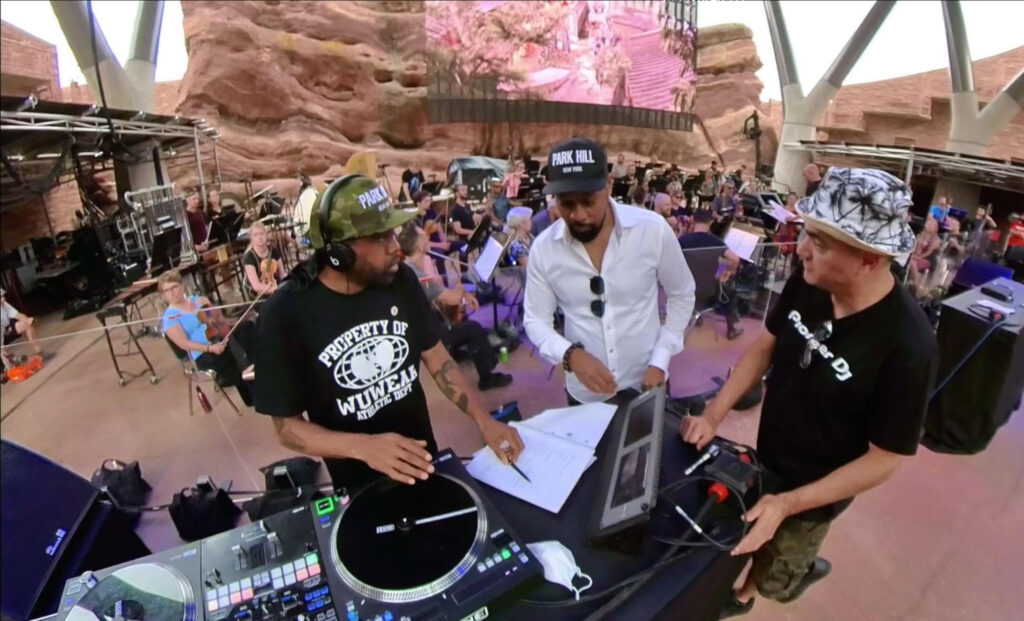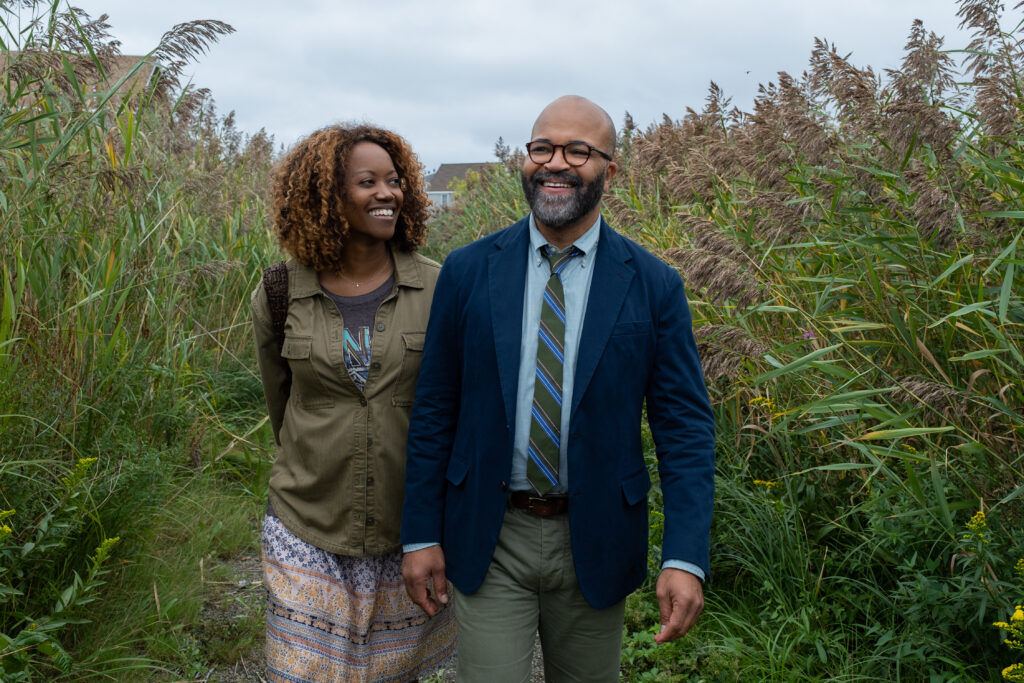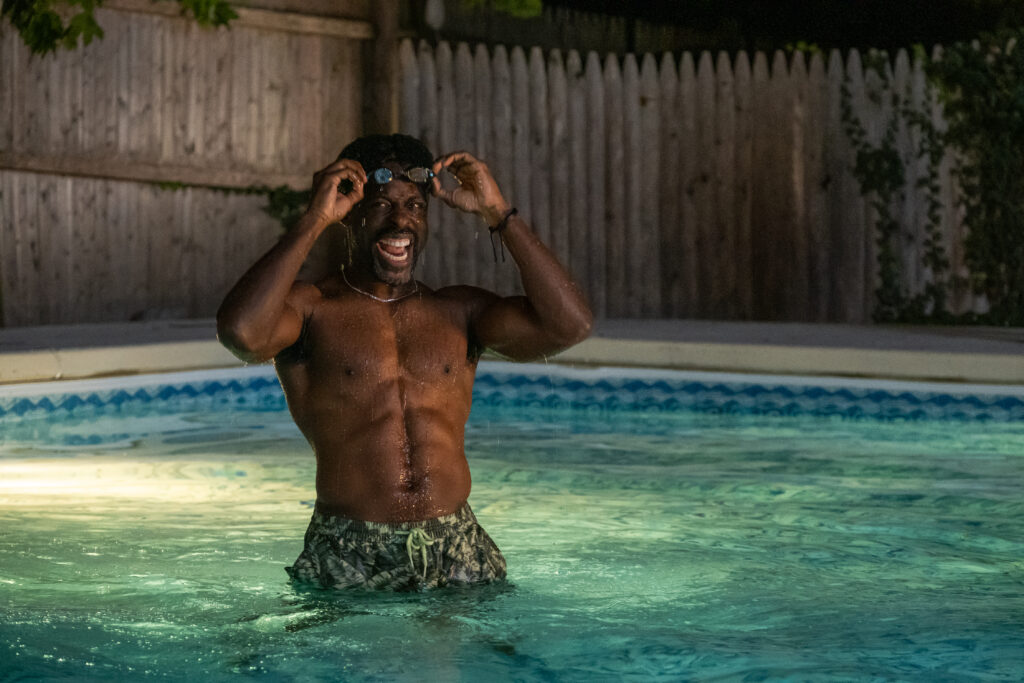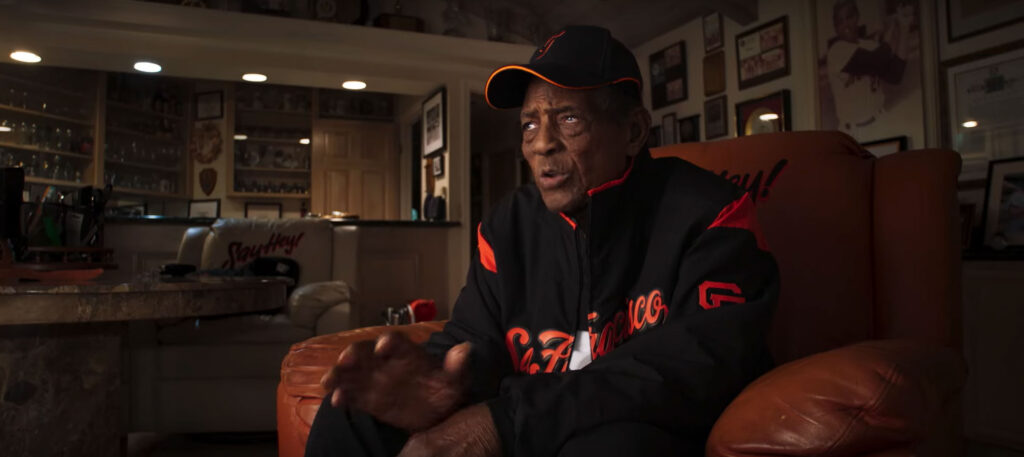November 24, 2023
by Carla Hay

“A Wu-Tang Experience: Live at Red Rocks Amphitheatre”
Directed by Gerald Barclay and RZA
Culture Representation: Taking place in 2021, the documentary film “A Wu-Tang Experience: Live at Red Rocks Amphitheatre” features a racially diverse group of people (mostly African American and white) who are connected in some way to hip-hip group Wu-Tang Clan’s concert with the Colorado Symphony at Red Rocks Amphitheatre in Morrison, Colorado, on August 13, 2021.
Culture Clash: Wu-Tang Clan and the Colorado Symphony defy the expectations of naysayers who think that hip-hop and classical music cannot be a good match.
Culture Audience: “A Wu-Tang Experience: Live at Red Rocks Amphitheatre” will appeal primarily to people who are fans of Wu-Tang Clan and people who are interested in documentaries about unusual musical pairings.

On August 13, 2021, hip-hop supergroup Wu-Tang Clan performed with the 60-piece Colororado Symphony at the iconic Red Rock Amphitheatre in Morrison, Colorado. “A Wu-Tang Experience: Live at Red Rocks Amphitheatre” chronicled this event on stage, backstage, and a few places elsewhere. It’s an entertaining but predictably formatted concert documentary with some film editing that’s a little rough around the edges. If anything, this movie is proof of how hip-hop and classical music can work well together. “A Wu-Tang Experience: Live at Red Rocks Amphitheatre” had its world premiere at the 2023 Urbanworld Film Festival.
Directed by RZA (a founding member of Wu-Tang Clan) and Gerald Barclay, “A Wu-Tang Experience: Live at Red Rocks Amphitheatre” shows how RZA was the driving force to pair Wu-Tang Clan with a symphony orchestra. RZA, who is also film composer, mentions at one point in the documentary that the inspiration for him to perform on stage with music that wasn’t all hip-hop started in 2016, when he performed the soundtrack to “The 36th Chamber of Shaolin” (a 1978 martial arts film), live at Fantastic Fest in Austin, Texas. That experience led to more opportunities for RZA to show more musical versatility in a live concert setting, he says in the documentary. RZA’s love of martial arts cinema has always been a big influence on Wu-Tang Clan.
“A Wu-Tang Experience: Live at Red Rocks Amphitheatre” has plenty of on-stage footage, but the movie includes a great deal off-stage footage, such as exclusive interview clips with RZA and the other members of Wu-Tang Clan: Method Man, Cappadonna, Ghostface Killah, U-God, GZA, Raekwon, Masta Killa and Inspectah Deck. Young Dirty Bastard, son of former Wu-Tang Clan member Ol’ Dirty Bastard (who died of a drug overdose in 2004, at the age of 35), makes a guest appearance during the concert and almost steals the show.
Ever since Wu-Tang Clan burst out of New York City’s Staten Island to become one of the most influential forces in hip-hop—starting with Wu-Tang Clan’s 1993 debut album, “Enter the Wu-Tang (36 Chambers)”—there has always been intrigue and controversy surrounding the group. All of the members have strong individual personalities (and have solo careers), which has led to periods of infighting and musical hiatuses for Wu-Tang Clan. RZA has branched out to becoming a film director and a comic book entrepreneur.
It’s been several years since the group’s had a new studio album (the most recent album is 2015’s “Once Upon a Time in Shaolin”), but Wu-Tang Clan still performs semi-regularly. This particular concert documentary shows them in good spirits and expressing overall camraderie. Raekwan comments, “I’m loving the togetherness.”
Masta Killa says of performing with the Colorado Symphony: “Having the orchestra there raises the bar. The goal was to raise it to the highest level possible. Are we there yet? I don’t know. We’ll know if this is a night to remember or a night where RZA just needs to shut the fuck up and stick to hip-hop.”
Method Man, the Wu-Tang Clan member with the most confident swagger on stage and offtsage, is shown in doing some weight lifting in a gym in the beginning of the documentary. He points to the spiderweb tattoos on his biceps, to proudly show how physically fit he is. He gives a lot of credit to RZA for being a visionary for Wu-Tang Clan and says, “We’re blessed that we’re still getting booked … A lot of our peers are dropping like flies.”
In the documentary, RZA reflects on a time when hip-hop wasn’t considered “real music” and has now evolved to be accepted into the mainstream. Case in point: Colorado Symphony resident conductor Christopher Dragon, who conducted the orchestra for this concert, says in the documentary that he grew up listening to Wu-Tang Clan and comes from a generational time period when hip-hop was fully accepted as real music. Dragon shares vivid memories of being 10 or 11 years old and listening to Wu-Tang Clan music that his older sister would play when she would drive them in a car without their parents around. Needless to say, Dragon is an enthusiastic musical partner for this concert.
Other people interviewed or featured in the documentary include Colorado Symphony artistic general manager Izabel Zambrzycki; Colorado Symphony viola player Mary Cowell; Colorado Symphony manager of ortistic Operations Dustin Knock; music producer Oliver “Power” Grant; WuMusic Group general manager Tareef Michael; DJ Mathematics; Jon “DJ Skane” Lugo; Young Dirty Bastard brand/operations manager Divine Everlasting. A diverse assortment of Wu-Tang Clan fans, who are not identifed by their names, are also interviewed at the concert. They say typical fan things, such as how the music affected their lives in positive ways and mention their favorite Wu-Tang Clan songs.
RZA comes across as the deep thinker of the group—someone who would rather show people what he can do, rather than brag about what he can do before it gets done. Although he occasionally says some cliché statements (“Music is a universal language”; “Wu-Tang is for the people”), RZA is the person in the group who makes the most effort to be inspirational in unifying not just the members of the group but also the people in the audience. Toward the end of the concert, RZA leads the audience to put their pands up to form the letter “w,” which not only stands for Wu-Tang Clan but also, as RZA says: “These w’s represent wings. You can fly above anything.”
Red Rocks Amphiteatre is unique and famous for being a venue that exists among natural rock formations that surround the venue. The beauty of the Red Rocks Amphitheatre location is well-showcased in the documentary, which has some stunning drone camera shots, as well as memorable wide-angle shots that allow viewers to soak up the atmosphere of this electrifying concert without actually being there.
The concert features many of Wu-Tang Clan’s best-known songs, including “Protect Ya Neck,” “Can It Be All So Simple,” “C.R.E.A.M.,” “Wu-Tang Clan Ain’t Nuthing Ta F’ Wit,” “It’s Yourz,” and “Triumph.” A few solo songs are performed, such as Young Dirty Bastard doing his version of Ol’ Dirty Bastard’s “Shimmy Shimmy Ya” and Method Man doing his own solo hit “Bring Da Pain.” In other words, it’s a crowd-pleasing set list.
Will people who don’t like hip-hop enjoy this documentary? It depends on how open-minded viewers are to seeing a documentary that might have music that isn’t necessarily a genre that they listen to on a regular basis. “A Wu-Tang Experience: Live at Red Rocks Amphitheatre” does a fairly good job of balancing the on-stage footage with the off-stage footage, but a few of the editing transitions are a bit choppy. Despite these minor flaws, it’s great to see a hip-hop documentary that isn’t a negative stereotype of being about feuding or violence. Wu-Tang Clan has defied a lot of expectations in the group’s long career. This documentary stands as a worthy testament of how taking musical risks can lead to meaningful creative rewards.




